DN1500板式精馏塔设计(含CAD零件装配图)
无需注册登录,支付后按照提示操作即可获取该资料.
DN1500板式精馏塔设计(含CAD零件装配图)(设计说明书14400字,CAD图纸4张)
摘 要
塔设备是化工、石油化工和炼油、医药、环境保护等工业部门的一种重要的单元操作设备。塔设备的设计包括两个部分:工艺设计和机械设计。机械设计部分要解决的问题,除了确定塔设备的各细节结构外,更重要的就是要做各种校核工作,以保证设计完成的塔设备不仅能够正常运转,而且必须符合国家安全生产的标准。其校核内容主要包括:质量载荷、地震载荷、风载荷等,还包括强度及稳定性校核。图纸包括一张装配图和零件图。
完成板式精馏塔成套装置主体部分结构设计,结构设计是指压力容器设计部分,即计算塔的壁厚,封头的结构及尺寸,精馏塔附件设计,接管设计等内容。本设计采用连续精馏分离苯-氯苯二元混合物的方法。连续精馏塔在常压下操作,被分离的由连续精馏塔中部进入塔内,以一定得回流比由连续精馏塔的塔顶采出含量合格的产品,由塔底采出精馏塔。纯度不低于99.8%,塔顶产品纯度不低于98%(质量分数)。
高径比很大的设备称为塔器。塔设备是化工、炼油生产中最重要的设备之一。它可使气(或汽)液或液液两相之间进行紧密接触,达到相际传质及传热的目的。常见的、可在塔设备中完成的单元操作有:精馏、吸收、解吸和萃取等。此外,工业气体的冷却与回收,气体的湿法净制和干燥,以及兼有气液两相传质和传热的增湿、减湿等。
在化工或炼油厂中,塔设备的性能对于整个装置的产品产量质量生产能力和消耗定额,以及三废处理和环境保护等各个方面都有重大的影响。据有关资料报道,塔设备的投资费用占整个工艺设备投资费用的较大比例。因此,塔设备的设计和研究,受到化工炼油等行业的极大重视。辅助装置及附件结构设计:接管的设计与相关法兰的选用、除沫器、人孔及其附件的设计。作为主要用于传质过程的塔设备,首先必须使气(汽)液两相充分接触,以获得较高的传质效率。此外,为了满足工业生产的需要,塔设备还得考虑下列各项传质效率。此外,为了满足工业生产的需要,塔设备还得考虑下列各项要求:
(1)生产能力大.在较大的气(汽)液流速下,仍不致发生大量的雾沫夹带、拦液或液泛等破坏正常操作的现象。
(2)操作稳定、弹性大。当塔设备的气(汽)液负荷量有较大的波动时,仍能在较高的传质效率下进行稳定的操作。并且塔设备应保证能长期连续操作。
(3)流体流动的阻力小。即流体通过塔设备的压力降小。这将大大节省生产中的动力消耗,以及降低经常操作费用。对于减压蒸馏操作,较大的压力降还使系统无法维持必要的真空度。
(4)结构简单、材料耗用量小、制造和安装容易。这可以减少基建过程中的投资费用。
(5)耐腐蚀和不易堵塞,方便操作、调节和检修。
事实上,对于现有的任何一种塔型,都不可能完全满足上述所有要求,仅是在某些方面具有独到之处。
全塔校核:包括塔体与封头厚度的确定、塔设备质量载荷及自振周期的计算、地震载荷与地震弯矩、风载荷与风弯矩计算、圆筒轴向应力和圆筒稳定性校核、塔设备压力试验时的应力和裙座轴向应力的校核.
关键词: 分块式塔盘; 不等壁厚; 筛板塔
Abstract
Tower equipment is chemical, petrochemical and refining, pharmaceutical, environmental protection, and other industrial department is a kind of important unit operation equipment. The design of the tower equipment consists of two parts: the process design and mechanical design. Mechanical design part of problem to solve, in addition to determine the details of the tower equipment structure outside, more important is to do all kinds of work check, in order to ensure that the design of the tower equipment can not only finish the normal operation, and must comply with the national safety production standards. Check the content mainly includes: quality load, earthquake loads, the wind loading, etc, also including the strength and stability are checked. Drawings including a assembly drawing and drawing.This design adopts the continuous distillation separation of benzene - chlorobenzene binary mixture method.Continuous distillation operation under the atmospheric pressure, be the separation of benzene - chlorobenzene binary mixtures by continuous rectification tower into the tower, central to must reflux ratio by a continuous rectification column and the content at the top of the column can qualified benzene, chlorobenzene from the bottom.Benzene chlorobenzene purity is not less than 99.8%, the overhead product purity is not less than 98% (mass fraction).
Than a lot of height to diameter device called columns.Tower equipment is one of the most important equipment in the production of chemical industry, oil refining.It can be quickly (or steam) liquid or liquid liquid two phase of close contact between, achieve the goal of international mass transfer and heat transfer.Common, can be done in the middle of tower equipment unit operations: distillation, absorption, desorption and extraction and so on.In addition, the cooling and recycling of industrial gases, gas net system of wet and dry, and both have liquid from mass and heat transfer of humidification, dehumidification, etc.In chemical or oil refinery, the performance of tower equipment for the entire unit production of products quality production capacity and consumption quota, and the three wastes treatment and environmental protection, and other aspects have a significant impact.Therefore, design and research of tower equipment, has been heavily promoted by the chemical refining industries.
Complete body of complete set of equipment of the column plate structure design, structure design is the design of pressure vessels parts, namely calculation of the tower wall thickness, the head of the structure and size, design of the column accessories, and took over the design, etc.As tower equipment is mainly used in mass transfer process, you must quickly (steam) a good contact with liquid two phase, in order to obtain higher mass transfer efficiency.In addition, in order to meet the needs of industrial production, tower equipment, but also have to consider the following mass transfer efficiency.In addition, in order to meet the needs of industrial production, tower equipment must also consider the following requirements:
(1) the production capacity is big. In larger gas (vapor) fluid velocity, are still not happen a lot of smuggled with foam fog, such as block liquid or liquid flood damage phenomenon of normal operation.
(2) the operating stability and flexibility.When the tower equipment, gas (vapor) fluid load have larger fluctuation, can still be stable under the high mass transfer efficiency of operations.And tower equipment should guarantee the long-term continuous operation.
(3) the fluid flow resistance is small.The fluid pressure drop through the tower equipment.This will greatly save the power consumption in production, and often lower operating cost.For vacuum distillation operation, larger pressure drop also make the system can not maintain necessary vacuum degree.
(4) simple structure, small amount of material consumption, easy manufacture and installation.This can reduce the investment cost in the process of construction.
(5) the corrosion resistance and not easy blockage, convenient operation, adjustment and maintenance.
In fact, for any existing tower type, can fully meet the requirements of all of the above, only has the unique feature in some ways.
Auxiliary equipment and accessories structure design: take over the design and the related flange of selecting, except the foaming machine, manhole and its annex design.
The tower check: including tower body and the head of the thickness is sure, tower equipment quality load and natural vibration period of calculation, earthquake loads and seismic moment, the wind load and the wind bending moment calculation, cylinder axial stress and cylinder stability checking, tower pressure test equipment of stress and axial stress of skirt a check.
Key words: Block tray; Different wall thickness; Sieve panel tower
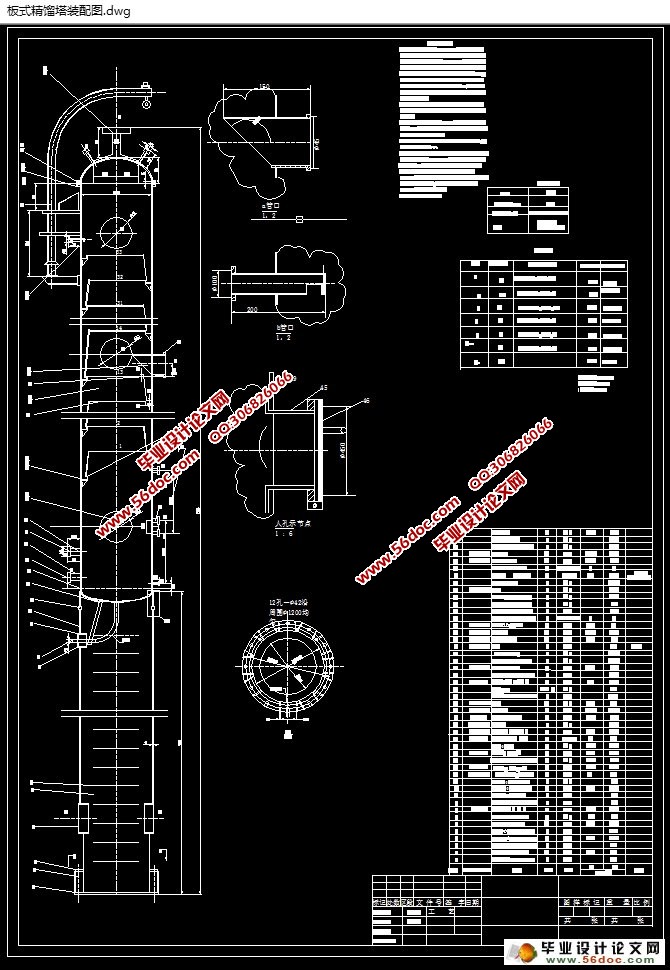
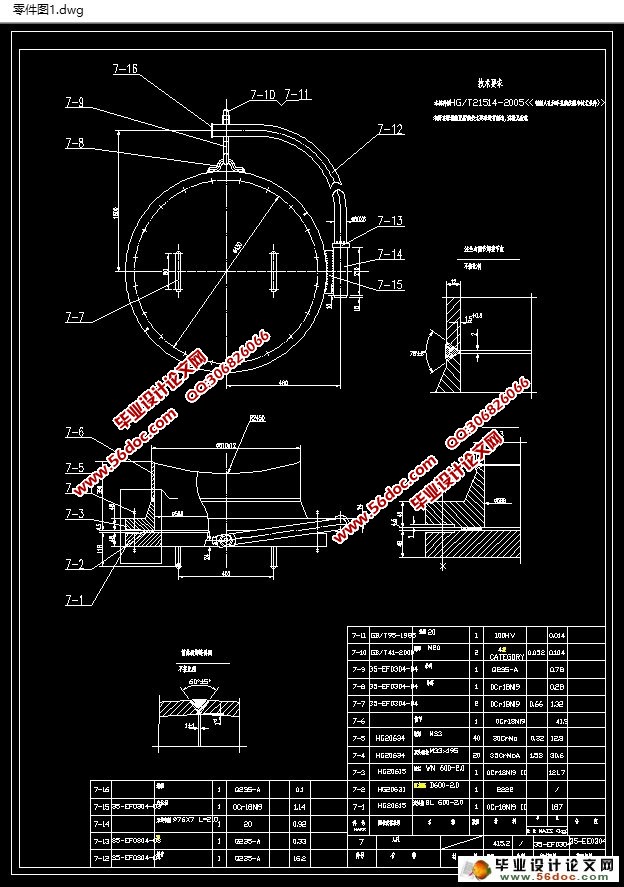
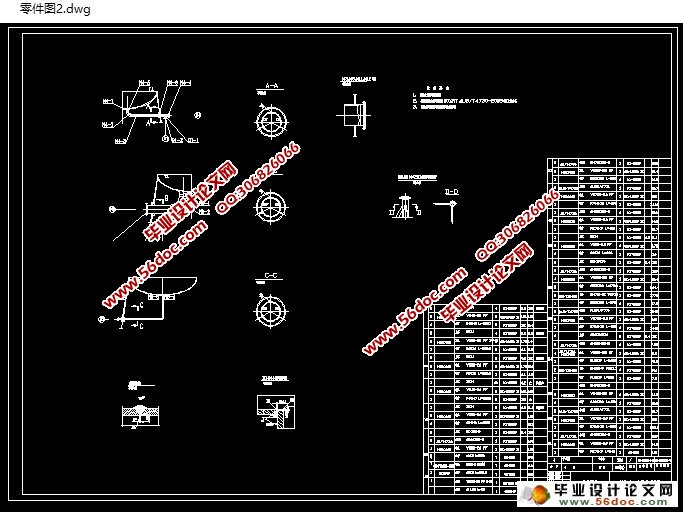
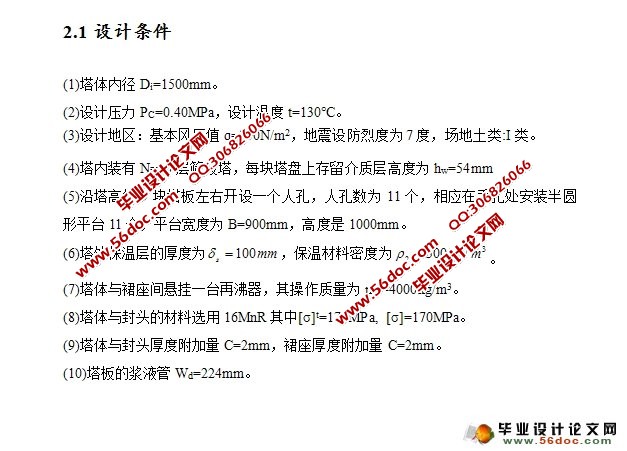
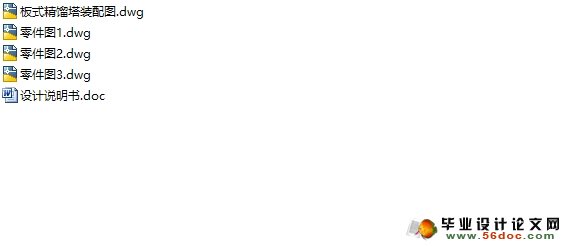
目 录
第一章 概述 1
1.1 塔设备概论 1
1.2 常压塔的工作原理及工艺曲线 1
第二章 板式精馏塔基本结构的设计 4
2.1设计条件 4
2.2.确定塔高 4
2.3 塔盘设计 6
2.3.1 塔盘形式及设计 6
2.3.2塔盘的结构设计 6
2.3.3 塔盘板 6
2.4 附件设计 8
2.4.1 人孔 8
2.4.2 接管 9
2.4.3 管法兰 10
2.4.4 吊柱 11
2.4.5 操作平台与梯子 11
2.4.6 保温层 12
2.4.7 裙座 12
第三章 精馏塔设备强度和稳定性计算 13
3.1 材料的选择 13
3.1.1 筒体和封头材料的选择 13
3.1.2 裙座材料的选择 13
3.1.3 接管的材料 13
3.2 厚度计算 13
3.2.1 厚度计算过程步骤 13
3.2.2 厚度计算 14
3.3设备质量载荷计算 14
3.3.1塔体圆筒、封头、裙座质量m01 14
3.3.2塔内构件质量m02 15
3.3.3保温层质量m03 15
3.3.4平台、扶梯质 15
3.3.5塔体分段 16
3.4偏心质量引起的偏心弯矩 16
3.5各种载荷引起的轴向应力 16
3.5.1设计压力引起的轴向应力 16
3.5.2操作质量引起的轴向压应力 17
3.5.3最大弯矩引起的轴向应力 17
3.6塔体和裙座危险截面的强度和稳定性校核 18
3.7塔体水压试验校核 19
3.8塔盘的机械计算 21
3.8.1塔盘的载荷 22
3.8.2塔盘构件的允许挠度和许用应力 22
3.8.3塔盘支承梁的设计 23
3.9地脚螺栓的设计 23
3.10 盖板 24
第四章 开孔补强 25
4.1 补强的判据 25
4.2 对人孔和检查孔进行补强 25
4.2.1补强计算方法判别 25
4.2.2开孔所需补强面积 26
4.2.3有效补强范围 26
4.2.4有效补强面积 26
4.2.5有效补强范围 27
4.3 对去再沸器入口进行补强 27
4.3.1补强计算方法判别 27
4.3.2开孔所需补强面积 27
4.3.3有效补强范围 28
4.3.4有效补强面积 28
4.3.5有效补强范围 29
4.4 再沸器返回口和塔顶气项出口 29
4.4.1补强计算方法判别 29
4.4.2开孔所需补强面积 29
4.4.3有效补强范围 29
4.4.4有效补强面积 30
4.4.5有效补强范围 30
第五章 主要零部件的制造工艺 31
5.1 筒体制造 31
5.2 封头 31
5.3 塔盘板制造 31
5.4 塔体及塔盘的制造技术条件的规定 32
总结 33
参考文献 34
致 谢 35
